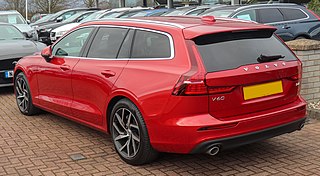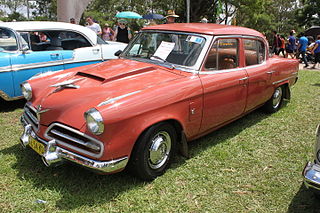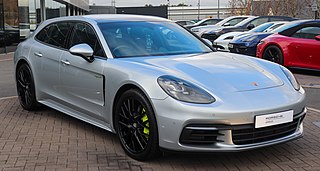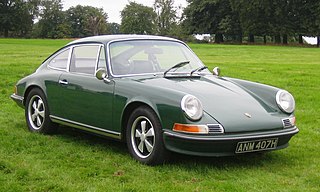Related Research Articles

The Porsche 356 is a sports car that was first produced by Austrian company Porsche Konstruktionen GesmbH (1948–1949), and then by German company Dr. Ing. h. c. F. Porsche GmbH (1950–1965). It was Porsche's first production automobile. Earlier cars designed by the Austrian company include Cisitalia Grand Prix race car, the Volkswagen Beetle, and Auto Union Grand Prix cars.

The Porsche 914 or VW-Porsche 914 is a mid-engined sports car designed, manufactured and marketed collaboratively by Volkswagen and Porsche from 1969 until 1976. It was only available as a targa-topped two-seat roadster powered by either a flat-4 or flat-six engine.

A station wagon or estate car, is an automotive body-style variant of a sedan with its roof extended rearward over a shared passenger/cargo volume with access at the back via a third or fifth door, instead of a trunk/boot lid. The body style transforms a standard three-box design into a two-box design—to include an A, B, and C-pillar, as well as a D-pillar. Station wagons can flexibly reconfigure their interior volume via fold-down rear seats to prioritize either passenger or cargo volume.

Packard was an American luxury automobile company located in Detroit, Michigan. The first Packard automobiles were produced in 1899, and the last Packards were built in South Bend, Indiana, in 1958.

A flat-four engine, also known as a horizontally opposed-four engine or boxer engine, is a four-cylinder piston engine with two banks of cylinders lying on opposite sides of a common crankshaft. The most common type of flat-four engine is the boxer-four engine, each pair of opposed pistons moves inwards and outwards at the same time.

The Porsche 959 is a sports car manufactured by German automobile manufacturer Porsche from 1986 to 1993, first as a Group B rally car and later as a road legal production car designed to satisfy FIA homologation regulations requiring at least 200 units be produced.

The Porsche 550 is a racing sports car produced by Porsche from 1953 until 1956. In that time only 90 Porsche 550s were produced, and they quickly established dominance in the 1.1- and 1.5- liter classes. The Porsche 550 is a mid-engine car with an air-cooled four-cylinder engine, following the precedent of the 1948 Porsche 356/1 prototype designed by Ferry Porsche. The mid-engine racing design was further developed with Porsche's 718 model; its advantages led to it becoming the dominant design for top-level racing cars by the mid-1960s.

The Volkswagen Type 4 is a compact / midsize family car, manufactured and marketed by Volkswagen of Germany as a D‑segment car from 1968 to 1974 in two-door and four-door sedan as well as two-door station wagon body styles. The Type 4 evolved through two generations, the 411 (1968–72) and 412 series (1972–74).
Economy car is a term mostly used in the United States for cars designed for low-cost purchase and operation. Typical economy cars are small, lightweight, and inexpensive to both produce and purchase. Stringent design constraints generally force economy car manufacturers to be inventive. Many innovations in automobile design were originally developed for economy cars, such as the Ford Model T and the Austin Mini.

The Studebaker Land Cruiser is an automobile that was produced by the Studebaker Corporation of South Bend, Indiana from 1934–1954. The Land Cruiser debuted at the World's Fair alongside the Silver Arrow, a product of Studebaker's former premium make Pierce-Arrow. It was also manufactured in Vernon, California.

The Studebaker Champion is an automobile which was produced by the Studebaker Corporation of South Bend, Indiana, from the beginning of the 1939 model year until 1958. It was a full-size car in its first three generations and a mid-size car in its fourth and fifth generation models, serving as the junior model to the Commander.

The Studebaker Lark is a compact car that was produced by Studebaker from 1959 to 1966.

The Starlight coupe is a unique 2-door body style that was offered by Studebaker Corporation of South Bend, Indiana from 1947 to 1955 on its Champion and Commander model series. It was designed by Virgil Exner, formerly of Raymond Loewy Associates along the lines of the ponton style that had just gone mainstream after the WWII.

The Porsche Panamera is a mid to full-sized luxury car manufactured and marketed by German automobile manufacturer Porsche across three generations using a front-engine, rear or all-wheel drive configuration.

The Renault 4CV is a car produced by the French company Renault from August 1947 through July 1961. It is a four-door economy car with its engine mounted in the rear and driving the rear wheels. It was the first French car to sell over a million units, and was superseded by the Dauphine.

The Packard Patrician is an automobile which was built by the Packard Motor Car Company of Detroit, Michigan, from model years 1951 through 1956. During its six years in production, the Patrician was built in Packard's Detroit facilities on East Grand Boulevard. The word "patrician" is Latin for a ruling class in Ancient Rome. It was the last "senior level" Packard until production ended in 1958.

The 1956 24 Hours of Le Mans was a race for Sports Cars which took place on 28 and 29 July 1956 on the Circuit de la Sarthe. The race was won by Ron Flockhart and Ninian Sanderson driving a Jaguar D-Type for the new Ecurie Ecosse team. This race also marked the golden jubilee of the Automobile Club de l'Ouest (ACO) founded in 1906, however because of the previous year's disaster, celebrations were deferred to 1957 to go along with the imminent 25th anniversary of the race.
The SA was Toyota's first new passenger car design after World War II. It was the first in a family of vehicles before the introduction of the Crown. A series of light trucks also shared the chassis and major components of these passenger cars.

The original Porsche 911 is a luxury sports car made by Porsche AG of Stuttgart, Germany. A prototype of the famous, distinctive, and durable design was shown to the public in autumn 1963. Production began in September 1964 and continued through 1989. It was succeeded by a modified version, internally referred to as Porsche 964 but still sold as Porsche 911, as are current models.
References
- 1 2 3 4 5 6 Carlsson, Mårten. "Studebaker på tyska" [Studebaker in German]. Klassiker (in Swedish). No. 2 July 2019.
- ↑ "Porsche's secret Studebaker". Motor Week. No. 8.7.1974.
- ↑ Ludvigsen, K. "A Studebaker by Porsche". Special-Interest Autos. No. Sep-Oct 1974.
- ↑ "Porsche's Four-Door Sedan - For Studebaker". Hemming’s sport’s and exotic car magazine. No. 9/2007.
- ↑ "The Rear-Engined Studebaker With the Heart of a Porsche". Motor1.com. Archived from the original on 6 July 2019. Retrieved 2019-07-06.
- ↑ "Axed! Cars that never reached the showroom | Autocar". www.autocar.co.uk. Retrieved 2019-07-06.
- ↑ Streather, Adrian (2008-05-15). Porsche 996 The Essential Companion: Supreme Porsche. Veloce Publishing Ltd. ISBN 9781845840969.
- ↑ Leffingwell, Randy (2013-10-20). Porsche 911: 50 Years. Motorbooks. ISBN 9780760344019.